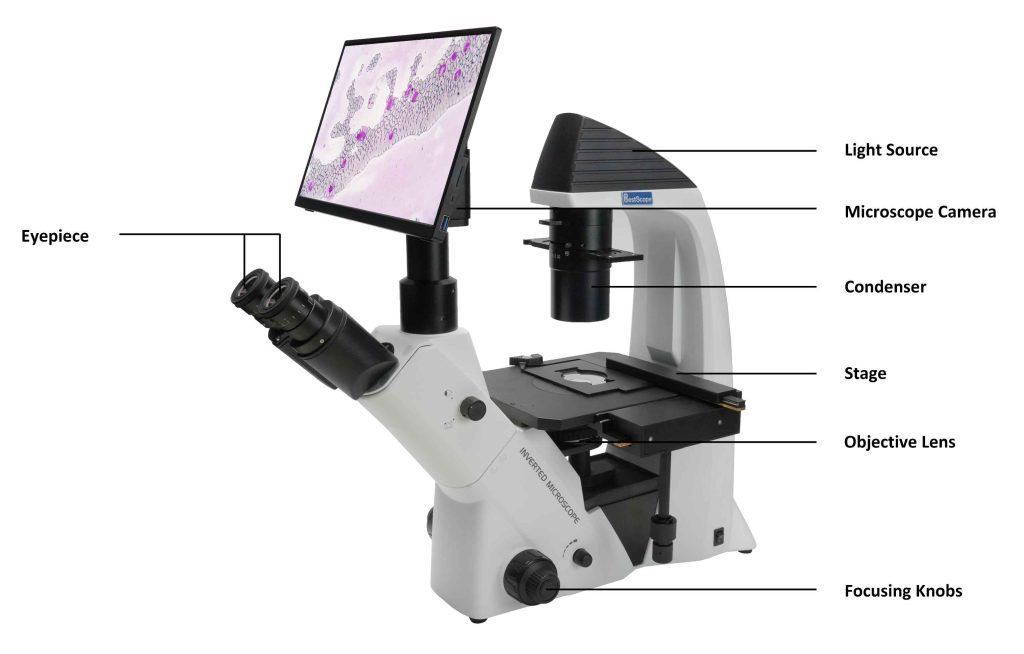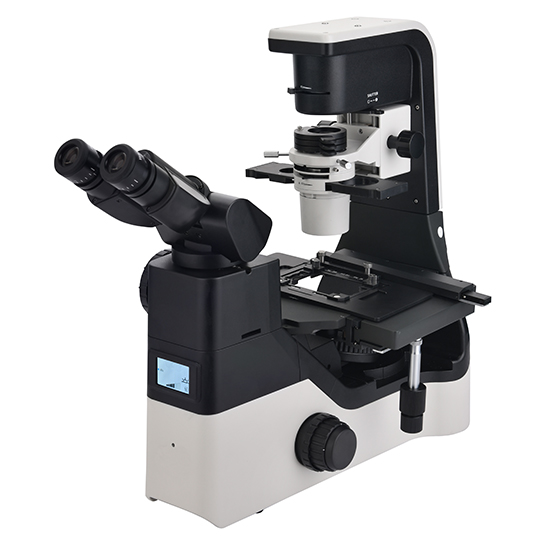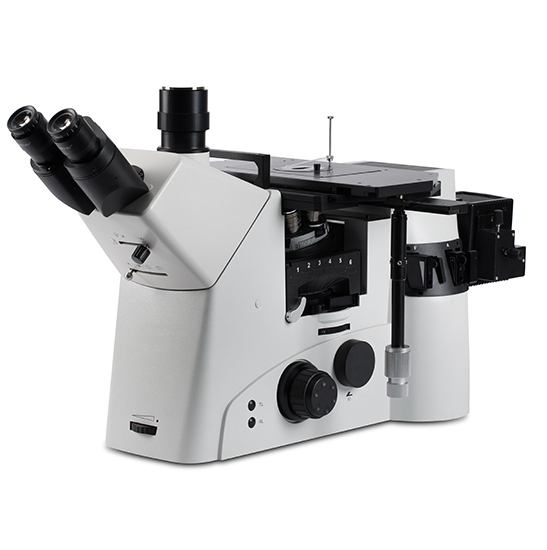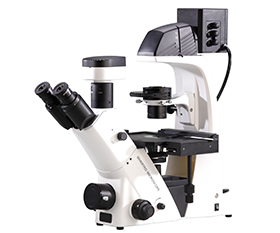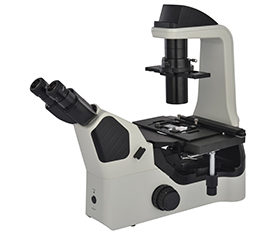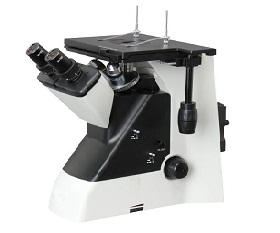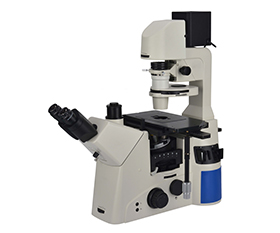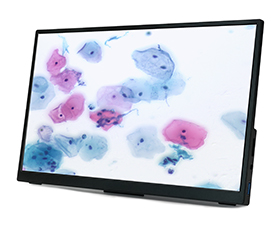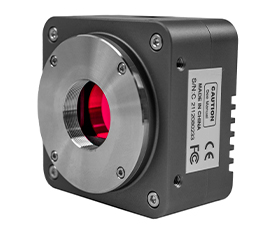What is an Inverted Microscope?
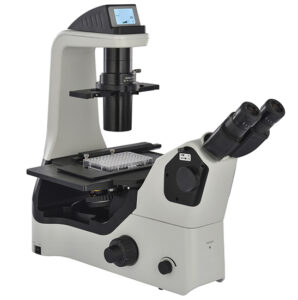 An inverted microscope is a type of optical microscope that has a unique design with its light source and condenser on the top, above the stage pointing down, while the objectives and turret are below the stage pointing up. The working principle of an inverted microscope is similar to that of an upright optical microscope. They both use light source to focus on a specimen, forming an image that can be observed through the objective lens.
An inverted microscope is a type of optical microscope that has a unique design with its light source and condenser on the top, above the stage pointing down, while the objectives and turret are below the stage pointing up. The working principle of an inverted microscope is similar to that of an upright optical microscope. They both use light source to focus on a specimen, forming an image that can be observed through the objective lens.
What are the main components of an inverted microscope?
Objective Lens: The objective lens is a critical component of the inverted microscope and is located below the specimen stage. It is responsible for magnifying the image of the specimen and capturing fine details.
Stage: The stage is a flat platform where the specimen is placed for observation. Inverted microscopes have spacious stages that can accommodate various sample containers, such as petri dishes, culture flasks, multi-well plates, and specialized chambers. This flexibility is essential for live cell imaging and long-term cell culture studies.
Condenser: The condenser is situated above the stage, and its primary function is to gather and focus light onto the specimen.It plays a crucial role in improving the quality of illumination, enhancing the clarity and contrast of the observed image. Some inverted microscopes may feature specialized condensers, such as phase contrast or DIC (differential interference contrast) condensers.
Light Source: The light source is positioned above the condenser and provides the necessary illumination to view the specimen. The light can be transmitted through the specimen (transmitted light illumination) or used to illuminate the specimen from the side (epi-illumination).
Eyepiece or Camera: The eyepiece is used to view the magnified image directly through the microscope. However, many modern inverted microscopes are equipped with cameras to capture high-resolution images and videos of the specimens.
Focusing Knobs: Inverted microscopes have coaxial coarse and fine adjustment. Fine focusing is used for minute adjustments to achieve optimal clarity, while coarse focusing rapidly moves the objective lens towards or away from the specimen.
BS-2093A Inverted Biological Microscope with BLC-280 LCD Digital Camera
The two basic types of inverted microscopes include biological inverted microscopes and metallurgical inverted microscopes.
What are the applications of biological inverted microscopes?
Biological inverted microscopes are specifically designed for observing living cells, tissues, and organisms in a laboratory environment. It is commonly used in cell biology, microbiology, and other fields where live specimens need to be examined.
Cell Culture Observation: They are used to observe and manipulate cells grown in culture dishes or multi-well plates. The inverted design allows easy access to the samples and provides a clear view of the cells from the bottom.
Live Cell Imaging: The phase contrast capabilities of inverted microscopes make them ideal for studying live cells. They allow to observe dynamic cellular processes such as cell division, cell migration, and intracellular transport in real-time. Fluorescence imaging techniques can also be employed to study specific cellular components or processes.
What are the applications of metallurgical inverted microscopes?
Unlike upright microscopes, metallurgical inverted microscopes objective lens is located below the stage, allowing for larger and bulkier specimen to be observed and manipulated easily. They usually have a high magnification feature that allows detailed inspection of the microstructure of metallic materials.
Material Analysis and Characterization: These microscopes are commonly used to analyze and characterize metallic materials, such as determining the grain size, phases present, and the nature and distribution of various inclusions, precipitates, or defects within the material.
Quality Control and Inspection: These microscopes are essential tools in quality control processes for metallic materials, allowing for the examination and evaluation of the microstructure and surface characteristics of parts to ensure they meet desired specifications.
BS-2094C Inverted Biological Microscope
BS-6045 Research Inverted Metallurgical Microscope
What are the advantages of inverted microscopes?
Large Specimen Handling: The inverted design of the microscope allows for larger and bulkier specimens, such as tissue culture flasks and petri dishes, to be easily accommodated and observed.
Long Working Distance: Inverted microscopes have a longer working distance, meaning that there is more space between the objective lens and the specimen. This allows for more flexibility in manipulating and observing specimens, especially when using tools such as micromanipulators or injection needles.
Reduced Contamination Risk: The inverted configuration minimizes the chances of contamination, as the objective lens does not come into contact with the culture medium or sample.
Wide Range of Biological Applications: such as cell biology, microbiology, developmental biology, cancer research, and stem cell studies.
What are the disadvantages of inverted microscopes?
Cost: Inverted microscopes are generally more expensive than conventional upright microscopes due to their specialized design and components.
Non-Compatibility with Traditional Slides: Inverted microscopes are not suitable for conventional microscope slides and coverslips, which can limit their use in certain applications.
Reduced Light Transmission: The light path in an inverted microscope is longer due to the placement of the objective lens below the specimen. This can result in slightly reduced light transmission compared to upright microscopes.
Bulkier Construction: Inverted microscopes can be bulkier and heavier than upright microscopes, making them less portable and requiring more bench space.
The resources are collected and organized on the Internet, and are only used for learning and communication. If there is any infringement, please contact us to delete.


